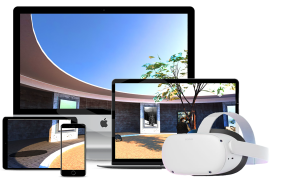Session Recording (3.0+)
This document applies to versions 3.0 onwards
Using Microsoft Clipchamp in Windows 11
Local recording is available to participants with Presenter, Editor or Owner roles. To upgrade a space see the guide here https://hyperspace.mv/academy/how-do-i/#hrclltiloz02c
Important: Recording is a space feature, if you are traversing a world you must stop recording in the space you started recording, save the recording, move to another space and start recording again.
If you’d like to record your journey across a world of spaces consider using a traditional third-party screen recording software. This will allow uninterrupted recording when moving between spaces.
Recording is only available on Google Chrome for desktop.
Recording is not available on mobile devices or other browsers at this time.
Recording will capture the
- 3D scene
- Video in the 3D scene
- Audio (check the audio section below for details about what is captured)
In order to capture the following HTML elements, make sure “Include UI” is selected. This will include:
- notifications
- avatar name tags
- chat history
- UI elements
- popup windows
- subtitles
- interactive scenario menus
Default | Include UI |
Recording may impact 3D or computer performance when in progress. This depends heavily on the resources of your computer.
How to Record
Start Recording
- Click the triple dot menu in the top right corner of the toolbar
- Click Start recording
- Click the Start button of the popup
If you select the Include UI option, another popup will appear where you will be asked for permission to share your browser tab. Make sure the “share audio” option is selected.
Recording in Progress
When recording is in progress a red border will appear around the 3D scene. This only appears for the person doing the capture, other users will not see it.
Stop Recording and Save
- Click the triple dot menu
- Choose Stop recording
- Click the Download video button
- Choose where to save your .webm video file
Chrome may display the downloaded file in a toolbar at the bottom of the browser, click the file to play it in your default video player or click the arrow next to it to open the folder on your computer.
Audio recording
Here is a table showing the different types of recording and what’s included in each:
UI not included (default) | UI included | |
AI Speech, Music and Sound effects in the 3d environment | ✖ | ✔ |
Conference calls and audio from video or screen sharing | ✔ | ✔ |
Audio from other tabs or apps | ✖ | ✖ |
Video Output
When the recording is finished, a video file will be ready for the user to download.
Video resolution: Video resolution matches the size of the captured window
Video container: webm
Video codec: VP9
Audio codec: Opus Audio @ 48000 Hz
Converting webm to mp4
Using Microsoft Clipchamp in Windows 11
Launch Clipchamp
- Choose Create a new video
- Import the webm from your file system
- Drag the imported file onto the timeline
- Export to MP4
- The file should be saved to your computer
Privacy considerations
As part of data privacy best practices it's good to let participants know if they are going to be recorded. Consider using a notification participants see on entering the experience that lets them know recording may occur.
Consider a message such as
“Your participation implies consent to recording/transcription. See privacy policy.”

